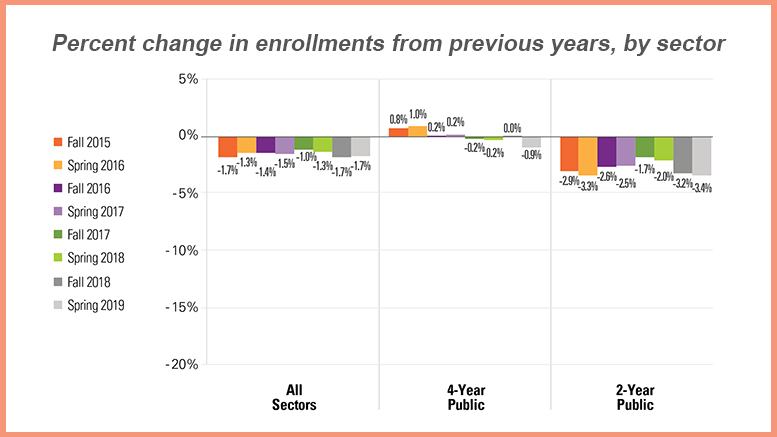After a slowing down of enrollment decreases over the past few years, new national figures show that spring-to-spring enrollments this year took a tumble. But enrollments for students under age 18 continued to rise, even though the numbers were small.
Enrollments at public two-year colleges dropped 3.4 percent this spring, a significant drop from the 2.0 percent decrease in spring-to-spring enrollments between 2017 and 2018, according to a new report from the National Student Clearinghouse (NSC) Research Center. Public two-year colleges saw a 2.5 percent drop in spring 2017 enrollments and a 3.3 percent dip in spring 2016.
Although policymakers follow fall enrollments more closely, the new figures may indicate a trend. Last fall, enrollments at public two-year colleges dropped by 3.2 percent, compared to a 1.7 percent dip in fall 2017. Fall enrollment decreases in this sector were 2.6 percent in 2016 and 2.9 percent in 2015.
Public two-year colleges weren’t alone in seeing larger enrollment dips. Spring enrollments at public four-year institutions saw a similar trend, with a 0.9 percent drop this spring, compared to a 0.2 percent drop the previous year.
“Colleges and universities in many regions continue to struggle from the combined effects of a strong job market and smaller numbers of high school graduates,” said Doug Shapiro, executive director of the NSC Research Center.
Overall, all U.S. higher education institutions saw a bigger dip in spring 2019 enrollments (-1.7 percent) compared to spring 2018 (-1.3 percent). For-profit four-year colleges saw the biggest drop, a whopping 19.7 percent, compared to a 6.8 percent drop in spring 2018. (They also saw a 10.1 percent drop in spring 2017, and a 9.3 percent dip in spring 2016.)
Enrollments at private, nonprofit four-year institutions increased by 3.2 percent this spring, but the NSC Research Center noted that it was largely due to large for-profit institutions converting to nonprofits.
The under-18 bump
The report breaks down enrollments based on age. There was a significant drop among traditional-age students at public two-year colleges, a slight slowdown in decreases among older students and a continued increase among students younger than 18.
For the under-18 group, spring enrollments rose 3.8 percent (or 17, 247 for a total of 469,549), compared to the 2.1 percent increase in the previous spring. In spring 2017, the increase was 10.6 percent. The popularity of dual/concurrent enrollments is likely what continues to push these numbers up.
Among students 18 to 24, spring enrollments dipped by 4.1 percent (or 120,164 to 2.8 million), compared to a decrease of 0.8 percent in spring 2018 and 2.5 percent in spring 2017. Among students older than 24, enrollments shrank by 4 percent (74,822 to 1.8 million), compared to a 4.6 percent drop in spring 2018 and a 5.0 percent drop in spring 2017.
The report also looks at spring enrollments at public two-year colleges by those seeking an associate degree and “other undergraduate” program, which include certificates, diplomas, non-credential programs and others. Both areas saw decreases: a 2.0 percent drop in associate-degree programs (compared to a 0.2 percent drop in spring 2018 and a 2.8 percent drop in spring 2017), and a 7.8 percent drop in other undergraduate programs (in spring 2018, the decrease was 7.4 percent, and in spring 2017 it was 1.6 percent).
The report saw similar trends when it examined full-time and part-time students at public two-year colleges. In spring 2019, full-time enrollment declined by 4.7 percent, compared to dropping 2.4 percent the previous year and 5.1 percent in spring 2017. Among part-time students, spring enrollment dipped 2.6 percent, compared to declines of 1.8 percent in spring 2018 and 1.0 percent in spring 2017.
Health care remains popular
Among clusters of programs at public two-year colleges, liberal arts and sciences, general studies and humanities remain the most popular, with 1.8 million students enrolled this spring, though it represents a 3.0 percent drop from last spring.
Health professions and related clinical sciences — the second most popular program — saw an 11 percent increase, with an enrollment of 851,084, compared to a 0.1 percent increase in spring 2018.
Business, management, marketing and related support — at the no. 3 spot — saw a 3.1 percent increase in enrollments, at 582,503. This countered decreases of 1.8 percent the previous year and 3.3 percent in spring 2017.
Program clusters that saw the largest percent increases include:
- architecture and related services (17.8 percent)
- personal and culinary services (17.6 percent)
- psychology (17 percent)
- science technologies/technicians (16.2 percent)
- construction trades (15.5 percent)

